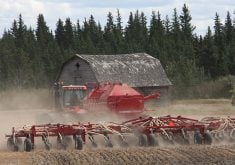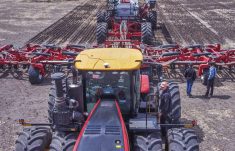Farmers are getting a jump on spring seeding, thanks to favourable weather and moisture conditions.
“We’re going to get into the field this week,” said Lynn Jacobson of Enchant, Alta.
Seeding usually starts during the first week of May on Jacobson’s farm.
“We’re earlier than typical in this area. We haven’t had any snow for a long time,” he said.“We could have been out seeding a week ago or two weeks if we wanted to, but the ground hadn’t warmed up.”
Read Also

New coal mine proposal met with old concerns
A smaller version of the previously rejected Grassy Mountain coal mine project in Crowsnest Pass is back on the table, and the Livingstone Landowners Group continues to voice concerns about the environmental risks.
Stewart Wells expects farmers in the Swift Current, Sask., area will be seeding this week as well.
Grant McLean, cropping management specialist with Saskatchewan Agriculture, said many farmers in his province could be planting four or five days earlier than normal because of a lack of snow cover and unseasonably warm early-spring temperatures.
Whether the crop emerges earlier than normal remains to be seen because that depends on soil temperature. A wheat crop seeded into five degree soil may take 12 days to come up while one that is planted into 10 degree soil can pop up in three days.
Ted Tkachyk was one of the first farmers to get a crop in the ground this spring.
The producer from Elm Creek, Man., planted his spring wheat April 2. While it’s an early start, April 2 doesn’t represent a record on his farm.
“We’ve (started) in March three or four times in my career,” said Tkachyk, reeve for the Rural Municipality of Grey.
He usually likes to get in the field in the middle of April but since he has to seed 5,000 acres with one cultivator, the earlier he starts the better.
“There’s a fair amount of moisture. It’s quite tacky, but it’s not going too bad,” said Tkachyk.
A few other producers in central Manitoba, the Red River Valley and around Portage la Prairie, Lowe Farm and Elm Creek began seeding in early April, said Pam de Rocquigny, Manitoba Agriculture feed grain specialist. Most are planting spring wheat, but she knows of one producer who planted canola.
Chuck Fossay, who farms near Starbuck, Man., decided to hold off on seeding his canola and soybeans until the middle of April because of cold nights and unsettled weather.
It turned out to be a prudent decision as temperatures in Manitoba and many other areas of the Prairies plummeted over the Easter weekend.
Daytime highs of 15 to 20 C in early April were replaced by highs between zero and 5 C. Some areas received heavy snowfall.
Recent rain and snowfall improved moisture conditions in many parts of the Prairies after an unusually dry winter, but some pockets still need moisture.
Jacobson said most farms south of Calgary could use rain. He wants to get his canola in the ground as soon as possible because it needs to be seeded only half an inch deep.
“There still is some moisture available at that depth but the longer we wait, we might have to go down three inches to get moisture,” he said.
Soil moisture is adequate for most operations north of Calgary, with the exception of the Peace River region.
McLean said conditions are shaping up nicely in Saskatchewan.
“Most producers are quite optimistic. In most cases, we’ve got pretty good moisture conditions.”
It is starting to look like a fairly typical year, in which the western half of the province is a lot drier than the eastern half.
Growers in places like Lloyd-minster, North Battleford, Kindersley and Rosetown are antsy to get in the fields before it becomes excessively dry.
“They wouldn’t mind a little shot of rain here just to warm up the soil and get things washed off and get the bugs rolling in the soil,” said McLean.
Conversely, farmers in southeastern Saskatchewan who were flooded out last spring don’t want rain. If conditions stay as they are, most will be able to seed a crop this year.
“It’s much more optimistic, particularly in the areas of the southeast where they were too wet,” he said.


















